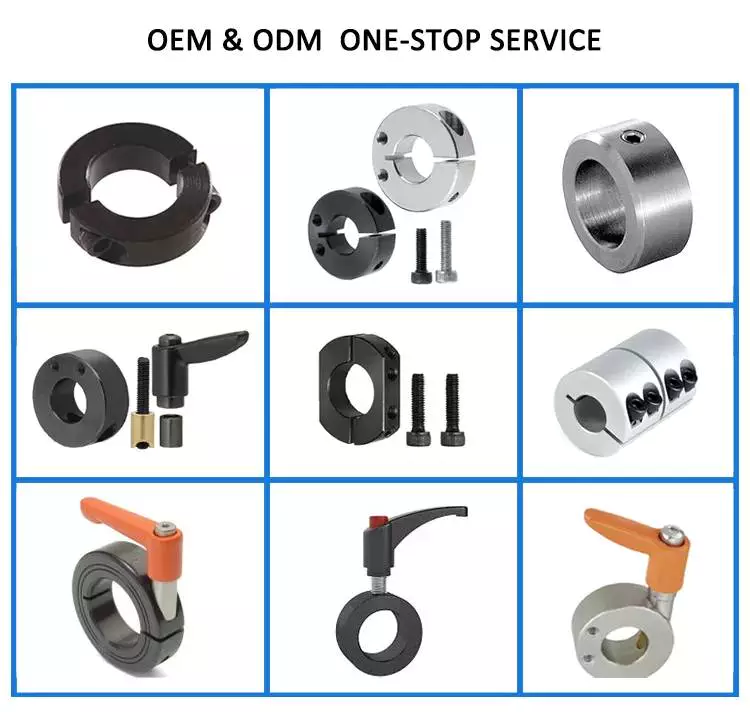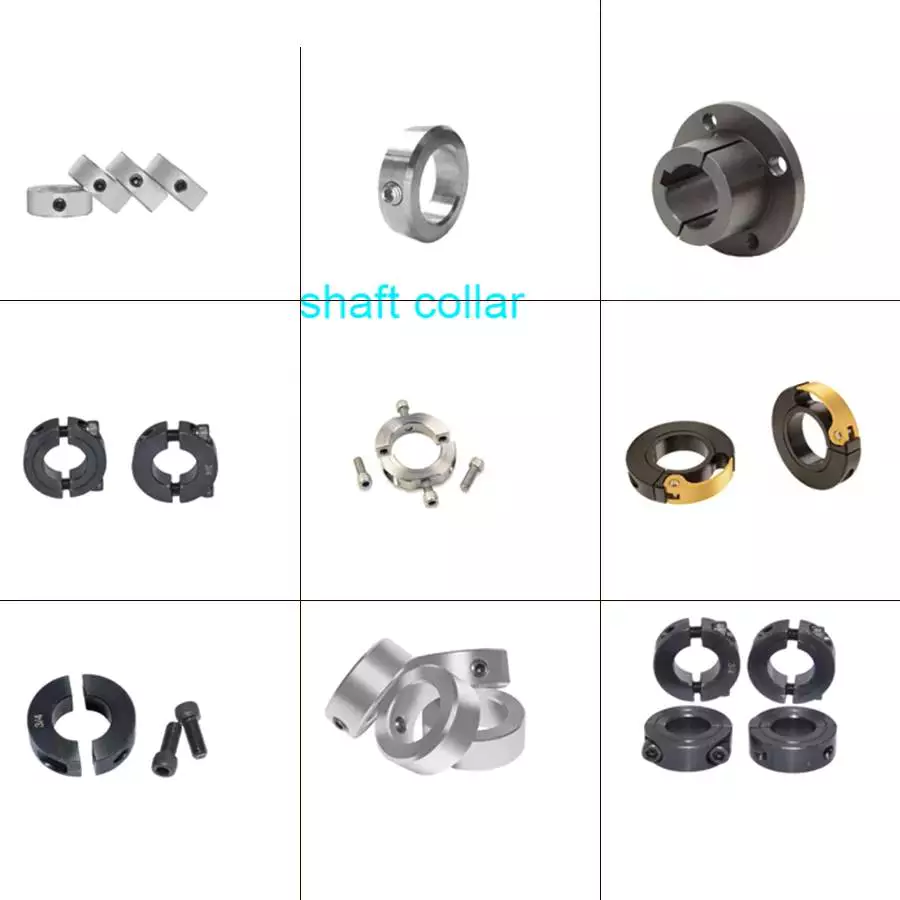
Are there guidelines on selecting shaft collars for applications with varying loads?
Yes, there are guidelines available to help in selecting shaft collars for applications with varying loads. When choosing shaft collars, it is important to consider the expected load conditions to ensure proper performance and prevent failures. Here are some guidelines to consider:
- Load Capacity Ratings: Shaft collars are typically assigned load capacity ratings by manufacturers. These ratings indicate the maximum load that a collar can withstand without deformation or failure. When selecting shaft collars for applications with varying loads, it is important to choose collars with load capacity ratings that exceed the maximum expected load in the application. This provides a safety margin and ensures reliable performance even under fluctuating load conditions.
- Dynamic Load Considerations: In applications with varying loads, it is important to consider both the static and dynamic load conditions. Static load refers to the constant load applied to the shaft collar, while dynamic load refers to the fluctuating or cyclic loads. The dynamic load can be higher than the static load due to factors such as vibrations, impacts, or operational variations. Ensure that the selected shaft collars have sufficient dynamic load capacity to handle the varying loads without premature failure.
- Material Strength: The material strength of the shaft collar is a critical factor in load-bearing capacity. Different materials, such as steel, stainless steel, aluminum, or plastic, have varying strength properties. For applications with varying loads, consider selecting shaft collars made from materials with higher strength and fatigue resistance to ensure they can withstand the load fluctuations without experiencing permanent deformation or fatigue failure.
- Design Features: Certain design features of shaft collars can enhance their load-bearing capacity and performance. For example, collars with a wider width or thicker cross-section can provide greater strength and resistance against deformation. Additionally, collars with multiple set screws or clamping mechanisms can distribute the load more evenly and provide a secure grip on the shaft, reducing the risk of slippage or misalignment under varying loads.
- Consulting with Manufacturers or Engineers: If you have specific application requirements or complex load conditions, it is advisable to consult with shaft collar manufacturers or mechanical engineers. They can provide expert guidance and recommend suitable collar designs, materials, and sizes based on the specific load variations in your application. Manufacturers often have engineering support teams that can assist in selecting the appropriate shaft collars for varying load conditions.
Remember that the selection of shaft collars for applications with varying loads should be based on a thorough understanding of the load characteristics, anticipated load range, and the specific requirements of the application. It is essential to choose collars that can safely and reliably handle the maximum expected loads to ensure optimal performance and prevent premature failure.

Can I find guidelines on lubricating and maintaining shaft collars for optimal performance?
Yes, guidelines on lubricating and maintaining shaft collars for optimal performance can be found. Proper lubrication and maintenance are essential for ensuring the smooth operation and longevity of shaft collars. Here are some common sources where you can find guidelines on lubricating and maintaining shaft collars:
- Manufacturer Websites: Many shaft collar manufacturers provide guidelines or recommendations for lubrication and maintenance on their websites. These guidelines may include information on the type of lubricant to use, the frequency of lubrication, and specific maintenance procedures. Visiting the websites of specific collar manufacturers and exploring their resources section or product documentation can help you find the lubrication and maintenance guidelines you need.
- Product Manuals or Documentation: When purchasing shaft collars, they often come with product manuals or documentation that include instructions for lubrication and maintenance. These manuals may provide step-by-step procedures, recommended lubricants, and maintenance schedules. Referencing the manuals or documentation that accompany your specific collar model can provide valuable guidance on how to properly lubricate and maintain your shaft collars.
- Industrial Machinery Handbooks: Handbooks or reference books related to industrial machinery or mechanical components often include sections on lubrication and maintenance practices. These resources can provide general guidelines and best practices for maintaining various types of mechanical components, including shaft collars. Checking reputable handbooks or reference books in the field of mechanical engineering can offer insights into lubrication techniques and maintenance procedures for optimal performance.
- Online Forums and Communities: Engaging with online industrial forums, discussion boards, or communities dedicated to mechanical components can provide access to valuable insights and experiences shared by professionals and experienced users. By posting inquiries about lubrication and maintenance techniques for shaft collars, you can gather practical advice, tips, and recommendations from individuals who have hands-on experience in the field.
- Consulting with Engineers or Experts: If you have access to engineers or experts in mechanical engineering or industrial equipment, they can provide personalized guidelines for lubricating and maintaining shaft collars based on your specific application and operating conditions. These professionals can consider factors such as the type of collar, the environment in which it operates, and any specific requirements you may have. They can offer insights and recommendations tailored to your needs.
When following lubrication and maintenance guidelines for shaft collars, it is important to adhere to the manufacturer’s recommendations and consider the specific characteristics of your operating environment. Proper lubrication techniques and regular maintenance can significantly contribute to the optimal performance and longevity of your shaft collars.

Can I find reviews on popular brands of shaft collars for user feedback?
Yes, it is possible to find reviews on popular brands of shaft collars to gain user feedback and insights. Here are some sources where you can look for reviews:
- Online Retailers: Online retailers such as Amazon, eBay, and industrial supply websites often feature customer reviews and ratings for products, including shaft collars. You can visit the product pages of specific brands or models of shaft collars and read user reviews to get an idea of their performance, quality, and user satisfaction. These reviews are typically provided by customers who have purchased and used the products, offering valuable feedback based on their experiences.
- Industrial Forums and Communities: Online industrial forums, discussion boards, or communities dedicated to mechanical components and equipment can be a valuable resource for finding user feedback on different brands of shaft collars. Participating in these communities and posting specific inquiries about certain brands or models can help you connect with industry professionals, engineers, or users who have firsthand experience with specific shaft collar brands. They can provide insights, recommendations, and share their opinions or experiences to assist you in making an informed decision.
- Manufacturer Websites: Some manufacturers maintain customer review sections or testimonials on their websites. Visiting the websites of popular shaft collar brands and exploring their product pages or customer support sections may provide access to reviews or feedback from users who have used their specific products. Manufacturer websites often include case studies, application examples, or testimonials that can give you an idea of the performance and user satisfaction associated with their shaft collars.
- Professional Publications and Magazines: Professional publications, trade magazines, or industry-specific journals related to mechanical engineering, industrial equipment, or power transmission may feature product reviews or evaluations. These publications often conduct independent tests, assessments, or interviews with professionals in the field to provide objective insights and feedback on various products, including shaft collars. Checking these publications or their online platforms can give you access to expert opinions and evaluations.
- Social Media and Online Groups: Social media platforms like LinkedIn or Facebook may have industry-specific groups or communities where professionals and enthusiasts discuss mechanical components and equipment. Joining these groups and engaging in conversations can help you connect with individuals who can provide feedback or recommendations based on their experiences with different brands of shaft collars.
When reading reviews, it’s important to consider multiple sources and evaluate the overall consensus rather than relying solely on individual opinions. Look for patterns, common experiences, and consider the credibility of the sources providing the reviews. Keep in mind that user feedback can vary, and personal preferences or specific application requirements may influence opinions. By gathering insights from various sources, you can make a more informed decision about the popular brands of shaft collars and their suitability for your specific needs.


editor by Dream 2024-05-03
by
Tags:
Leave a Reply